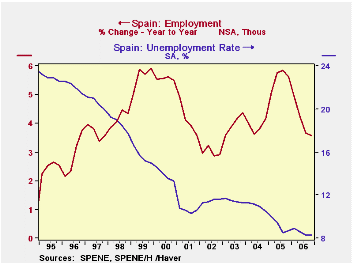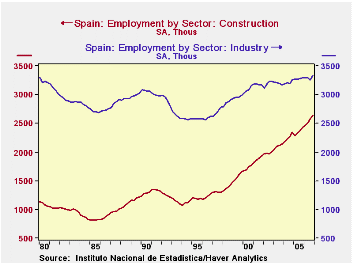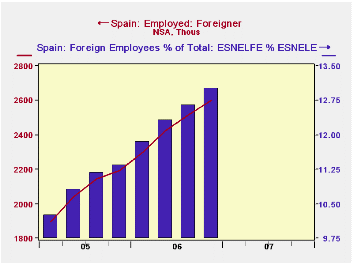 Global| Jan 26 2007
Global| Jan 26 2007Employment in Spain Surpasses 20 Million in Q4; Foreign Workers Increase Share of Jobs
Summary
The number of employed workers in Spain passed 20 million in Q4, a record and a new milestone. The Spanish labor market continues to impress with its vigor. Growth rates are moderating a bit, but conditions remain strong overall. The [...]

The number of employed workers in Spain passed 20 million in Q4, a record and a new milestone. The Spanish labor market continues to impress with its vigor. Growth rates are moderating a bit, but conditions remain strong overall. The unemployment rate was 8.3%, seasonally adjusted, the same as in Q3 and the lowest since Q2 1979, more than 27 years ago. Labor force participation increased to 58.6%, also a record for this data, which began just over 30 years ago; this rate has gone up about a percentage point a year for the last five years.
We wrote about Spain's unique labor market last October, on the release of Q3 data. We noted then that the "industry" sector was holding up in Spain, even as it was declining elsewhere in Europe. In Q4, Spanish industry employment firmed, so it now has 31,000 more jobs, 0.9%, than in Q4 2005. European-wide data are not yet available for Q4, but through Q3, they were running 1.0% below a year ago. In other Spanish activity, the service sector had slower growth in Q4, "just" 4.3% year-on-year; the year as a whole was up 5.1%, the third year in the last four with more than 5% growth in service sector jobs. The real star is construction, as is easily evident in the second graph. Job growth there has picked up this year, with 8.3% in Q4 over the year earlier. For all of 2006, construction jobs increased 7.9%, the fastest in five years.
Another striking feature of the Spanish labor market is the participation of foreign workers. It may be that other countries are experiencing this phenomenon, but we have not been aware of it. Foreigners in Spain who are of working age (over 16) constitute 10.2% of that age segment of the total population, but they are 13% of the employees. While they have a higher unemployment rate than the population as a whole, 12.0% versus the total 8.3%, they are far more active in the labor market, with a participation rate of 77.6% compared to the overall 58.3%. Clearly immigrants come to Spain to look for work and persist in trying to get it.
Seasonal adjustment of Spain's employment and unemployment series is done by Haver Analytics. These series are in Haver's "G10" database. Other data, especially that on foreign workers, is carried in the SPAIN database, the "country-sourced" database in which data are presented in the style in which they are published by the national statistical sources.
| SPAIN | Q4 2006 | Q3 2006 | Q4 2005 | 2006 | 2005 | 2004 |
|---|---|---|---|---|---|---|
| Employment (Millions, SA) | 20.01 | 19.81 | 19.32 | 19.75 | 18.97 | 17.97 |
| Industry | 3.33 | 3.26 | 3.30 | 3.29 | 3.28 | 3.21 |
| Construction | 2.64 | 2.58 | 2.44 | 2.54 | 2.36 | 2.25 |
| Services | 13.13 | 13.02 | 12.59 | 12.97 | 12.34 | 11.52 |
| Unemployment Rate (%, SA) | 8.3 | 8.3 | 8.7 | 8.5 | 9.1 | 11.0 |
| Participation Rate (%, SA) | 58.6 | 58.4 | 57.7 | 58.3 | 57.3 | 56.3 |
| Foreign % of Working Age Population (NSA) | 10.2 | 9.9 | 9.0 | 9.8 | 8.5 | -- |
| Foreign % of Employment (NSA) | 13.0 | 12.7 | 11.3 | 12.5 | 10.9 | -- |
Carol Stone, CBE
AuthorMore in Author Profile »Carol Stone, CBE came to Haver Analytics in 2003 following more than 35 years as a financial market economist at major Wall Street financial institutions, most especially Merrill Lynch and Nomura Securities. She has broad experience in analysis and forecasting of flow-of-funds accounts, the federal budget and Federal Reserve operations. At Nomura Securites, among other duties, she developed various indicator forecasting tools and edited a daily global publication produced in London and New York for readers in Tokyo. At Haver Analytics, Carol is a member of the Research Department, aiding database managers with research and documentation efforts, as well as posting commentary on select economic reports. In addition, she conducts Ways-of-the-World, a blog on economic issues for an Episcopal-Church-affiliated website, The Geranium Farm. During her career, Carol served as an officer of the Money Marketeers and the Downtown Economists Club. She has a PhD from NYU's Stern School of Business. She lives in Brooklyn, New York, and has a weekend home on Long Island.





